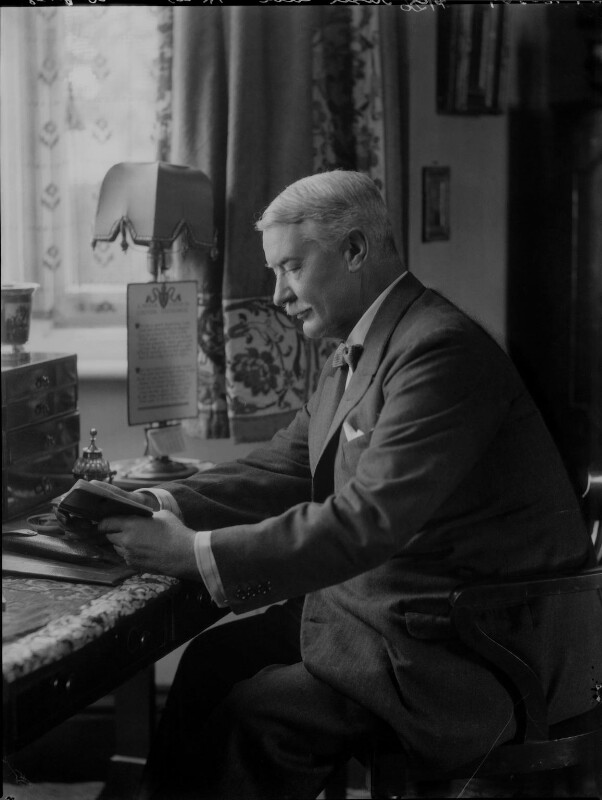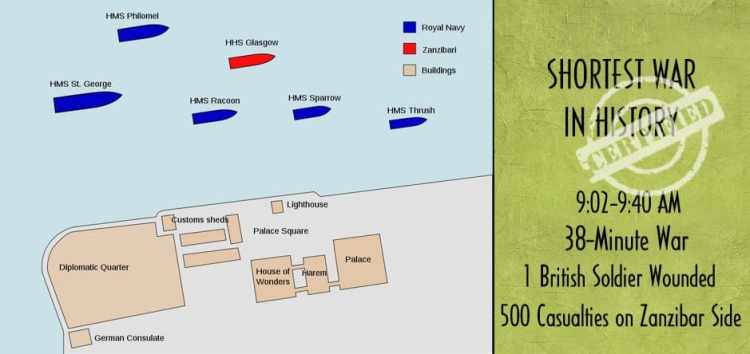No body wants a war, at least not many right-minded people. If there has to be a war then it is best for all involved if it is as short and painless as possible. History is full of lengthy, bloody wars so if you’ve never heard of the 1896 British-Zanzibar war then it is probably for good reasons. Mainly that the entire war lasted about the same amount of time it will take me to write this post.

The Anglo-Zanzibar War was a military conflict fought between the United Kingdom and the Zanzibar Sultanate on 27 August 1896. The conflict lasted between 38 and 45 minutes, marking it as the shortest recorded war in history.
The story begins with the signing of the Heligoland-Zanzibar treaty between Britain and Germany in 1890. This treaty effectively drew up spheres of influence between the imperial powers in East Africa; Zanzibar was ceded to British influence, whilst Germany was given control over mainland Tanzania.
With this new found influence, Britain declared Zanzibar a protectorate of the British Empire and moved to install their own ‘puppet’ Sultan to look after the region. Hamad bin Thuwaini, who had been a supporter of the British in the area, was given the position in 1893.

Hamad ruled over this relatively peaceful protectorate for just over 3 years until, on August 25, 1896, he died suddenly in his palace. Although the truth will never be fully known about the causes for his death, it is widely believed that his cousin, Khalid bin Barghash had him poisoned.
This belief is compounded by the fact that within a few hours of Hamad’s death, Khalid had already moved into the palace and assumed the position of Sultan, all without British approval.
Needless to say the local British diplomats were not at all happy with this turn of events, and the chief diplomat in the area, Basil Cave, quickly declared that Khalid should stand down. Khalid ignored these warnings and instead starting gathering his forces around the Palace.

These forces were surprisingly well armed, although it’s worth noting that quite a few of their guns and cannons were actually diplomatic gifts that had been presented to the former Sultan over the years! By the end of 25th August, Khalid had his palace secured with almost 3,000 men, several artillery guns and even a modestly armed Royal Yacht in the nearby harbour.
At the same time, the British already had two warships anchored in the harbour, the HMS Philomel and the HMS Rush, and troops were quickly being sent ashore to protect the British Consulate and to keep the local population from rioting. Cave (pictured to the right) also requested backup from another nearby British ship, the HMS Sparrow, which entered the harbour on the evening of the 25th August.

Even though Cave had a significant armed presence in the harbour, he knew that he did not have the authority to open hostilities without express approval of the British government. To prepare for all eventualities, he sent a telegram to the Foreign Office that evening stating: “Are we authorised in the event of all attempts at a peaceful solution proving useless, to fire on the Palace from the men-of-war?” Whilst waiting for a reply from Whitehall, Cave continued issuing ultimatums to Khalid but to no avail.
The next day, two more British warships entered the harbour, the HMS Racoon and the HMS St George, the latter carrying Rear-Admiral Harry Rawson, commander of the British fleet in the area At the same time, Cave had received a telegraph from Whitehall stating:
“You are authorised to adopt whatever measures you may consider necessary, and will be supported in your action by Her Majesty’s Government. Do not, however, attempt to take any action which you are not certain of being able to accomplish successfully.”
The ultimatum given to Khalid expired at 09:00 East Africa Time (EAT) on 27th August, by which time the British had gathered three cruisers, two gunboats, 150 marines and sailors, and 900 Zanzibaris in the harbour area. The Royal Navy contingent were under the command of Rear-Admiral Harry Rawson while their Zanzibaris were commanded by Brigadier-General Lloyd Mathews of the Zanzibar army (who was also the First Minister of Zanzibar). Around 2,800 Zanzibaris defended the palace; most were recruited from the civilian population, but they also included the sultan’s palace guard and several hundred of his servants and slaves. The defenders had several artillery pieces and machine guns, which were set in front of the palace sighted at the British ships. A bombardment, opened at 09:02, set the palace on fire and disabled the defending artillery.
A small naval action took place, with the British sinking the Zanzibari royal yacht HHS Glasgow and two smaller vessels, and some shots were fired ineffectually at the pro-British Zanzibari troops as they approached the palace. The flag at the palace was shot down and fire ceased at 09:40.
The sultan’s forces sustained roughly 500 casualties, while only one British sailor was injured. It’s worth noting that a large number of the casualties included the wounded whilst others were killed during a fire in the palace.

As for Khalid, he managed to escape with a small group of loyal followers to the local German Consulate. Despite repeated calls from the British for his extradition, he was smuggled out of the country on October 2nd by the German navy and taken to modern day Tanzania. It was not until British forces invaded East Africa in 1916 that Khalid was finally captured and subsequently taken to Saint Helena for exile. After ‘serving time’, he was later allowed to return to East Africa where he died in 1927.
Of the 500 casualties or wounded, most of the deaths occurred because of the fire that engulfed the Royal Palace of Zanzibar Sultanate. During the war, the British fired 1,000 rifle rounds, 4,100 machine gun rounds and 500 shells.
With Khalid out of the way, London was free to place the pro-British Sultan Hamud on the throne of Zanzibar, and he ruled on behalf of Her Majesty’s Government for the next six years. Britain outlawed what had made Zanzibar famous for centuries, slavery. Zanzibar remained a British protectorate until 1963. The following year Zanzibar merged with the Republic of Tanganyika which together form the modern nation of Tanzania.
Thanks Stephen for digging it out & writing about this.
I lived in Zanzibar for 3 months doing my Divemaster course @ Nungwi beach & visited Stone Town number of times.
Have U been?
Let me know if and when you need guides as we discussed a while ago.
Cheers Steve 07883624937
Sent from my iPhone
>
LikeLike